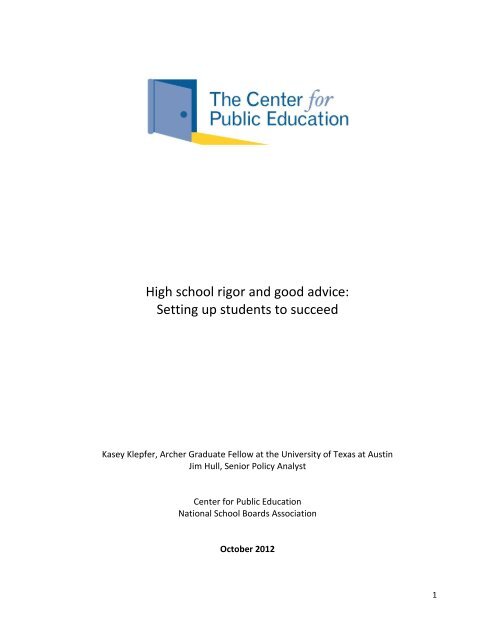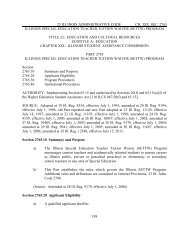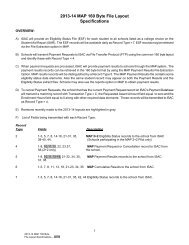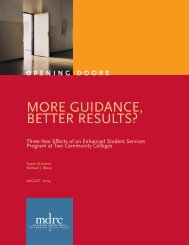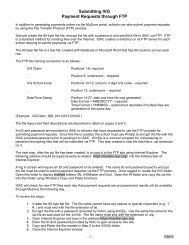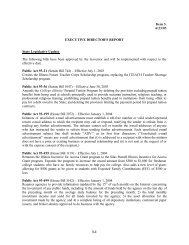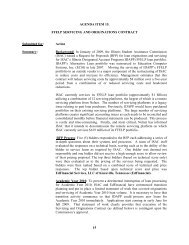High school rigor and good advice: Setting up students to succeed
High school rigor and good advice: Setting up students to succeed
High school rigor and good advice: Setting up students to succeed
You also want an ePaper? Increase the reach of your titles
YUMPU automatically turns print PDFs into web optimized ePapers that Google loves.
<strong>High</strong> <strong>school</strong> <strong>rigor</strong> <strong>and</strong> <strong>good</strong> <strong>advice</strong>:<br />
<strong>Setting</strong> <strong>up</strong> <strong>students</strong> <strong>to</strong> <strong>succeed</strong><br />
Kasey Klepfer, Archer Graduate Fellow at the University of Texas at Austin<br />
Jim Hull, Senior Policy Analyst<br />
Center for Public Education<br />
National School Boards Association<br />
Oc<strong>to</strong>ber 2012<br />
1
<strong>High</strong> <strong>school</strong> <strong>rigor</strong> <strong>and</strong> <strong>good</strong> <strong>advice</strong>:<br />
<strong>Setting</strong> <strong>up</strong> <strong>students</strong> <strong>to</strong> <strong>succeed</strong><br />
We know that around two-thirds of the future jobs in the United States will require some sort of postsecondary<br />
education. Job reports show that by 2018, there will be 47 million jobs created by new<br />
industries <strong>and</strong> a retiring workforce(Carnevale, Smith <strong>and</strong> Strohl 2010). Of these jobs, 33 percent will<br />
require at least a bachelor’s degree <strong>and</strong> 30 percent will require an associate’s degree or some college<br />
training (Carnevale, Smith <strong>and</strong> Strohl 2010).<br />
The dem<strong>and</strong> for workers with a college education is growing faster than the s<strong>up</strong>ply of graduates. By<br />
2018, we will have produced 3 million fewer college graduates than the labor market dem<strong>and</strong>s<br />
(Carnevale, Smith <strong>and</strong> Strohl 2010). President Obama has set a national goal <strong>to</strong> produce 8 million more<br />
graduates by 2020 in order <strong>to</strong> make the United States the world leader in college attainment.<br />
One effective way <strong>to</strong> get us on the path <strong>to</strong> reaching this goal is <strong>to</strong> prevent the <strong>students</strong> who enter<br />
college from leaving before they earn a credential. Results vary between institutions, but overall in 2009<br />
only 57.8 percent of <strong>students</strong> attending a four-year institution graduated in less than six years (Knapp,<br />
Kelly-Reid <strong>and</strong> Ginder 2012 ). Only 32.9 percent of <strong>students</strong> attending two-year institutions graduated<br />
in three years (Knapp, Kelly-Reid <strong>and</strong> Ginder 2012 ). If instead 90 percent of our current freshmen<br />
persisted <strong>to</strong> degree, we would produce an additional 3.8 million graduates by 2020 -- enough <strong>to</strong> meet<br />
the labor market’s needs in this decade <strong>and</strong> nearly halfway <strong>to</strong> meeting the President’s 2020 goal.<br />
Further, if graduation rates for 2-year institutions increased <strong>to</strong> 60 percent <strong>and</strong> 90 percent for 4-year<br />
institutions, they would produce an additional 6.6 million graduates by 2020—enough <strong>to</strong> meet the labor<br />
market’s needs in this decade as well as the President’s 2020 goal. 1<br />
Main Findings<br />
<strong>High</strong>-level mathematics: Students improved their<br />
likelihood of staying on track <strong>to</strong>ward a credential<br />
in two- <strong>and</strong> four-year colleges by 10 <strong>to</strong> 20 percent<br />
if they had taken high <strong>school</strong> math though precalculus<br />
<strong>and</strong> calculus.<br />
Advanced Placement/International<br />
Baccalaureate courses: Taking an AP/IB course<br />
also had a dramatic effect on <strong>students</strong>’ chance of<br />
persisting even when <strong>students</strong> fail the end-ofcourse<br />
AP test. The more of these courses a<br />
student <strong>to</strong>ok, the higher their persistence rates<br />
were.<br />
Academic advising: Talking <strong>to</strong> an academic<br />
advisor in college either “sometimes” or “often”<br />
significantly improved <strong>students</strong>’ persistence rates<br />
as much as 53 percent. This relationship held true<br />
for <strong>students</strong> in two- <strong>and</strong> four-year institutions.<br />
In all cases, the impact was greatest for low SES<br />
<strong>students</strong> who began high <strong>school</strong> as low achievers.<br />
The logical place <strong>to</strong> begin is <strong>to</strong> examine first <strong>to</strong><br />
second year persistence rates because <strong>students</strong><br />
are more likely <strong>to</strong> drop out their first year than<br />
any other year of college (NCHEMS 2010). In<br />
this report “persistence” refers <strong>to</strong> first-year<br />
<strong>students</strong> in a two- or four-year institution, <strong>and</strong><br />
are still in college one year after. This is<br />
sometimes called “first-year retention” or<br />
“first-year persistence”, <strong>and</strong> these phrases<br />
could be used synonymously in this report. Of<br />
all entering first time freshman in 2004, 79<br />
percent returned for the second year of<br />
college. The rate is much lower for two-year<br />
institution <strong>students</strong>, with only 64 percent<br />
persisting. 2<br />
Keep in mind, <strong>students</strong> who transfer from one<br />
institution <strong>to</strong> another are still considered<br />
“persisting.” However, many individual<br />
2
colleges report much lower persistence rates because of the sizable number of <strong>students</strong> who transfer<br />
following their first year.<br />
This report aims <strong>to</strong> provide a better underst<strong>and</strong>ing of which <strong>students</strong> are not persisting past their first<br />
year of college, <strong>and</strong> what kinds of fac<strong>to</strong>rs influence this. If state policymakers, post-secondary<br />
institutions, <strong>school</strong> districts, <strong>and</strong> high <strong>school</strong>s can implement policies that increase first <strong>to</strong> second year<br />
persistence, we believe it can dramatically increase the amount of <strong>students</strong> who eventually obtain a<br />
post-secondary degree.<br />
The main findings in this report point <strong>to</strong> the highest level of math in high <strong>school</strong>, taking an AP/IB course,<br />
<strong>and</strong> meeting with college academic advisors as fac<strong>to</strong>rs that can greatly improve the chances that a<br />
student will persist <strong>to</strong> their second year of college. This report separates four-year from two-year<br />
institutions so that we can see the differences in their student populations <strong>and</strong> persistence. After<br />
describing the findings, this report will provide some suggested actions that <strong>school</strong> districts <strong>and</strong><br />
policymakers can take <strong>to</strong> help improve student post-secondary persistence.<br />
Defining the Student Gro<strong>up</strong>s Used in This Study<br />
To better isolate the effects of the high <strong>school</strong><br />
experience we controlled for the socioeconomic<br />
status (SES) <strong>and</strong> prior academic achievement of<br />
the <strong>students</strong>. This allowed us <strong>to</strong> compare<br />
<strong>students</strong> with similar SES levels <strong>and</strong> academic<br />
achievement. Although we could not control<br />
completely for other potential fac<strong>to</strong>rs like student<br />
motivation, this approach still provides a closer<br />
apples <strong>to</strong> apples comparison of the effects of<br />
certain variables. There is a common argument<br />
that <strong>school</strong>s can only do so much <strong>to</strong> help <strong>students</strong><br />
<strong>succeed</strong> because poverty <strong>and</strong> other fac<strong>to</strong>rs<br />
associated with low SES, as well as the level of<br />
academic performance that the student shows<br />
are such determinant fac<strong>to</strong>rs for success. While<br />
it is true that these can be related <strong>to</strong> persistence<br />
in college, this report finds that even after taking<br />
a student’s SES <strong>and</strong> prior achievement in<strong>to</strong><br />
account, strategies emerge that high <strong>school</strong>s can<br />
implement <strong>to</strong> improve persistence.<br />
In order <strong>to</strong> analyze the impact of these high<br />
<strong>school</strong> variables, we gro<strong>up</strong>ed the <strong>students</strong> in this<br />
study in<strong>to</strong> several categories. We looked at<br />
<strong>students</strong> with high SES <strong>and</strong> high prior academic<br />
achievement, those with low SES 3 <strong>and</strong> low prior<br />
academic achievement, <strong>and</strong> those with middle<br />
SES <strong>and</strong> middle prior academic achievement. For<br />
the SES measure we use a definition used by the<br />
Reasoning for Student Gro<strong>up</strong> Rankings<br />
We chose <strong>to</strong> compare <strong>students</strong> between the<br />
21 st <strong>and</strong> 80 th percentiles in both SES <strong>and</strong> 10 th<br />
grade st<strong>and</strong>ardized scores. There are two<br />
reasons for this:<br />
First, the number of four-year institution<br />
<strong>students</strong> in the bot<strong>to</strong>m quartile of SES<br />
<strong>and</strong> achievement is very small.<br />
Conversely, there are not many two-year<br />
institution <strong>students</strong> in the <strong>to</strong>p quintile of<br />
SES <strong>and</strong> achievement. If we used just<br />
the highest <strong>and</strong> lowest ranked <strong>students</strong> it<br />
would not give as accurate a portrayal of<br />
the characteristics of the majority of<br />
college <strong>students</strong>.<br />
Second, the student gro<strong>up</strong>s in this<br />
analysis do not represent the extremes of<br />
SES or academic achievement. Any<br />
differences between the low <strong>and</strong> high<br />
SES/achievement gro<strong>up</strong> is conservative.<br />
Surprisingly, this report did not have <strong>to</strong><br />
compare the extreme <strong>to</strong>p <strong>and</strong> bot<strong>to</strong>m<br />
quintiles of SES/achievement in order <strong>to</strong><br />
show the dramatic differences in<br />
persistence between both gro<strong>up</strong>s.<br />
3
federal government <strong>and</strong> a specific variable in the ELS survey. 4 We use 10 th grade st<strong>and</strong>ardized test<br />
scores as a proxy for a student’s previous academic achievement. 5<br />
In no way should this suggest that all <strong>students</strong> with a low SES have low academic achievement or those<br />
<strong>students</strong> with high SES will have high academic achievement. There are many <strong>students</strong> that have a low<br />
SES <strong>and</strong> a very high 10 th grade st<strong>and</strong>ardized scores, but they are outside of the scope of this report.<br />
These gro<strong>up</strong>ings are meant <strong>to</strong> demonstrate the effects that the variables of this report have on gro<strong>up</strong>s<br />
that traditionally have a better chance of persisting <strong>and</strong> <strong>students</strong> who have a worse chance of persisting.<br />
It is also important <strong>to</strong> note that the <strong>students</strong> in this study were in college before the global recession hit<br />
in 2008. While financial concerns do have a role in persistence, these findings are not affected by the<br />
recession. For this report the following gro<strong>up</strong>s refer <strong>to</strong>:<br />
<strong>High</strong> SES/Achievement Gro<strong>up</strong>: Students with a high level of SES <strong>and</strong> high prior academic<br />
achievement. These <strong>students</strong> have a higher chance of persistence than the other student gro<strong>up</strong>s<br />
Middle SES/Achievement Gro<strong>up</strong>: Students with an average level of SES <strong>and</strong> average prior academic<br />
achievement. This gro<strong>up</strong> represents <strong>students</strong> with neither a high or low chance of persisting<br />
Low SES/Achievement Gro<strong>up</strong>: Students with a low level of SES <strong>and</strong> below low prior academic<br />
achievement. These <strong>students</strong> have a lower chance of persistence than the other gro<strong>up</strong>s<br />
<strong>High</strong> SES/Achievement Gro<strong>up</strong>: These <strong>students</strong> have above average levels of SES, the 61 st <strong>to</strong> 80 th<br />
percentile (4 th quintile) of all <strong>students</strong>. SES can represent an economic or social position in comparison<br />
<strong>to</strong> other <strong>students</strong>. Students with a high SES could have any combination of family income, parents’<br />
education, or any of the five fac<strong>to</strong>rs that make <strong>up</strong> the SES variable in ELS 2002 data that would rank it<br />
higher than the other <strong>students</strong>. 6 This ranking is highly correlated with academic success including<br />
persistence in college. <strong>High</strong> SES/achievement <strong>students</strong> also had above average scores on 10 th grade<br />
st<strong>and</strong>ardized tests (61 st <strong>to</strong> 80 th percentile or 4 th quintile). This gro<strong>up</strong> attempts <strong>to</strong> show the effects that<br />
the variables in this report have on persistence for <strong>students</strong> who already have a better-than-most<br />
chance of persistence.<br />
Middle SES/Achievement Gro<strong>up</strong>: Students in this gro<strong>up</strong> are in the middle levels of SES. They also scored<br />
in the middle range on their 10 th grade st<strong>and</strong>ardized tests. They are in the 41 st <strong>to</strong> 60 th percentile of both<br />
characteristics (3 rd quintile). They represent a category of <strong>students</strong> that has no clear advantage or<br />
disadvantage over the other two gro<strong>up</strong>s when it comes <strong>to</strong> persistence in college.<br />
Low SES/Achievement Gro<strong>up</strong>: These <strong>students</strong> have below average levels of SES <strong>and</strong> scored lower on 10 th<br />
grade st<strong>and</strong>ardized tests, in the 21 st <strong>to</strong> 40 th percentile of both (2 nd quintile). This student gro<strong>up</strong><br />
represents <strong>students</strong> who persist at lower levels than the other two gro<strong>up</strong>s. The low SES could present<br />
financial concerns in college which could negatively impact their chances persisting. It is also important<br />
<strong>to</strong> note that <strong>students</strong> from low SES families are more likely <strong>to</strong> be first generation college <strong>students</strong> <strong>and</strong><br />
may be less familiar with college expectations <strong>and</strong> requirements, fac<strong>to</strong>rs which could prevent them from<br />
persisting. Similarly achieving <strong>students</strong> from higher SES families are more likely <strong>to</strong> have a family his<strong>to</strong>ry<br />
of going <strong>to</strong> college <strong>and</strong> would be more likely <strong>to</strong> persist.<br />
4
The ELS 2002 data<br />
Technical notes on methodology<br />
This report examines postsecondary education persistence using the Educational Longitudinal Study<br />
(ELS) from 2002. The study collected data from a nationally representative sample of 2002 high <strong>school</strong><br />
sophomores, <strong>and</strong> collected follow-<strong>up</strong> data from them in 2004 as seniors, <strong>and</strong> again in 2006. From the<br />
original sample of over 16,000 <strong>students</strong> this report looked at the 9,060 <strong>students</strong> who:<br />
1. Graduated high <strong>school</strong><br />
2. Enrolled in a two or four-year institution immediately following their senior year<br />
3. Were still enrolled in January of 2006<br />
Issues in Measuring Persistence<br />
These 9,060 <strong>students</strong> represent over two million <strong>students</strong> in the United States. For the definition of<br />
persistence in this report, a student who started <strong>school</strong> in a four-year college the summer or fall<br />
immediately out of high <strong>school</strong> (2004) was counted as persisting if in January of 2006 they were either<br />
still enrolled in that college, transferred <strong>to</strong> another four-year college, or transferred <strong>to</strong> a two-year<br />
institution. Conversely, if a student started at a two-year institution <strong>and</strong> transferred <strong>to</strong> a four-year college<br />
then this was also counted as persisting. This definition of persistence reflects the national goal of<br />
increasing the number of <strong>students</strong> with some sort of post-secondary degree. One assumption of this<br />
report is that a student who transfers from a four-year <strong>to</strong> a two-year institution should count as persisting<br />
<strong>to</strong>wards obtaining a degree, <strong>and</strong> vice versa.<br />
There are many critiques of using the particular definition of persistence in this report. First of all, not all<br />
<strong>students</strong> start college in the summer or fall term directly after high <strong>school</strong>. There is a modest bias in<br />
drawing samples from <strong>students</strong> who enroll immediately after high <strong>school</strong>. Earlier longitudinal studies<br />
show that of college-going 12 th graders who start college within a year after high <strong>school</strong>, 6 percent in the<br />
summer, 82 percent start in the fall, <strong>and</strong> 12 percent in the winter/spring (Adelman 2006). The definition of<br />
persistence used in this report might therefore overestimate the true persistence of <strong>students</strong> from their<br />
first <strong>to</strong> second year because Latino <strong>students</strong>, African American <strong>students</strong>, <strong>and</strong> <strong>students</strong> with a low socioeconomic<br />
status are less likely <strong>to</strong> start in the fall. These student populations have higher rates of nonpersistence.<br />
However, this slight bias is unlikely <strong>to</strong> drastically effect persistence calculations in this<br />
report, <strong>and</strong> the sample has an appropriate number of <strong>students</strong> from every SES level <strong>and</strong> from the<br />
traditionally underrepresented races. This report looks at <strong>students</strong> that start immediately after high <strong>school</strong><br />
because we can more easily find correlations between high <strong>school</strong> variables <strong>and</strong> their effects on<br />
persistence. While imperfect, this definition is adequate <strong>to</strong> look at which types of student persist more,<br />
<strong>and</strong> which characteristics contribute <strong>to</strong> their persistence.<br />
College-Readiness<br />
Policy researchers have attempted <strong>to</strong> point out the difference between a student that is college-eligible<br />
<strong>and</strong> a student that is college-ready (Conley 2007). Policy advocates believe that U.S. high <strong>school</strong>s are<br />
creating college-eligible <strong>students</strong> who can meet state graduation requirements <strong>and</strong> public college<br />
admissions requirements, but they are not in fact college-ready (Conley 2007). Being college-ready<br />
means a student should enroll <strong>and</strong> <strong>succeed</strong> in first-year college course without needing remediation.<br />
Remediation can stall entry in<strong>to</strong> college “gateway” courses which can lead <strong>to</strong> falling behind in credits or<br />
non-persistence. In the first year of college a student’s preparation is tested <strong>and</strong> most reflects the<br />
preparation the student had in high <strong>school</strong>.<br />
5
The findings<br />
<strong>High</strong>-level math courses<br />
Previous studies suggest that the highest level of math in high <strong>school</strong> can be one of the strongest<br />
predic<strong>to</strong>rs of college success (Adelman 2006). College Algebra is one of the most failed <strong>and</strong> dropped<br />
courses in college with Calculus following closely behind (Adelman 2006). These math courses can often<br />
be a “gateway” course in<strong>to</strong> majors that have <strong>to</strong> be taken in the first year of college. In this report we<br />
see the same effects of math in persistence. We looked at two indica<strong>to</strong>rs of math ability: the highest<br />
level of math that the student <strong>to</strong>ok in high <strong>school</strong> <strong>and</strong> the math st<strong>and</strong>ardized test scores of all collegebound<br />
<strong>students</strong> based on the math sections of college-entrance exams ACT <strong>and</strong> SAT <strong>and</strong> the ELS 12 th<br />
grade math assessment.<br />
For the highest level of math, high <strong>school</strong> math courses were gro<strong>up</strong>ed in<strong>to</strong> the following categories 7 :<br />
Algebra I, Geometry, or Less<br />
Algebra II<br />
Trigonometry, Statistics/Probabilities, or Algebra III<br />
Pre-Calculus or Calculus<br />
The higher the math course a student takes in high <strong>school</strong>, the greater the probability that a student will<br />
persist, no matter the level of SES or prior academic achievement. Chart 1 <strong>and</strong> Chart 2 show the<br />
increase in probability for persisting for each Student Gro<strong>up</strong>. Only 5.5 percent of <strong>students</strong> in four-year<br />
institutions had not taken Algebra II. Surprisingly, 33 percent of <strong>students</strong> in two-year institutions had<br />
taken less than Algebra II. This is striking, because simply taking Algebra II in addition <strong>to</strong> Algebra I <strong>and</strong><br />
Geometry raises the probability of persisting for two-year institution <strong>students</strong> by 10 <strong>to</strong> 20 percent, <strong>and</strong><br />
around the same for four-year institution <strong>students</strong>.<br />
Four-year institution: A student in the high SES/achievement gro<strong>up</strong> has a 10 percent better chance in a<br />
four-year institution of persisting if that student <strong>to</strong>ok Pre-Calculus or Calculus rather than Algebra II. For<br />
the low SES/achievement gro<strong>up</strong> they are 22 percent more likely <strong>to</strong> persist.<br />
6
Two-year institution: If they <strong>to</strong>ok Pre-Calculus or Calculus beyond Algebra II, a student in the high<br />
SES/achievement gro<strong>up</strong> is about 18 percent more likely <strong>to</strong> persist compared <strong>to</strong> the low SES/achievement<br />
gro<strong>up</strong> which is 27 percent more likely <strong>to</strong> persist. In two-year institutions, 33 percent of <strong>students</strong> enter<br />
with Algebra I, Geometry, or less as their highest level of high <strong>school</strong> math. Only around half of these<br />
<strong>students</strong> persist <strong>to</strong> their second year, <strong>and</strong> these <strong>students</strong> represent almost half of all non-persisting<br />
<strong>students</strong> in two-year institutions. What is also striking is a student in the low SES/achievement gro<strong>up</strong><br />
who takes one math course higher than Algebra II, has a better chance of persisting than a high or<br />
middle SES/achievement student with only Algebra I. Low SES/achievement <strong>students</strong> can increase their<br />
chances of persisting by 44 percent by taking Pre-Calculus or Calculus instead of only Algebra I or<br />
Geometry.<br />
Math test scores<br />
Four-year institutions: Math skills appear <strong>to</strong> be a very important predic<strong>to</strong>r of persistence in four-year<br />
institutions. Looking at math scores from college entrance exams such as SAT/ACT 8 shows persistence<br />
rates are higher as you get higher scores. There are not an adequate amount of <strong>students</strong> with high<br />
ACT/SAT math scores for college-goers in two-year institutions for analysis (about 5 percent), so we only<br />
looked at four-year institutions. If we just look at the ACT Math scores (or equivalent SAT Math scores)<br />
of all college-going <strong>students</strong>, there is a dramatic effect from achieving a high score 9 . When comparing<br />
<strong>students</strong> with similar SES <strong>and</strong> prior achievement at four-year institutions, the increased chances from<br />
scoring high instead of low on the College-going ACT/SAT Math scores are as follows:<br />
<strong>High</strong> SES/Achievement Gro<strong>up</strong>: Scoring a 28 rather than an 18 on the ACT (or equivalent SAT Math<br />
score) increases your chances of persisting by 9 percent.<br />
Middle SES/Achievement Gro<strong>up</strong>: Scoring a 28 rather than an 18 on the ACT (or equivalent SAT Math<br />
score) increases your chances of persisting by 12 percent.<br />
Low SES/Achievement Gro<strong>up</strong>: Scoring a 28 rather than an 18 on the ACT (or equivalent SAT Math<br />
score) increases your chances of persisting by 15 percent.<br />
7
The same phenomenon is seen in 12 th grade st<strong>and</strong>ardized math scores. In four-year institutions, 27<br />
percent of <strong>students</strong> in the bot<strong>to</strong>m quintile of the st<strong>and</strong>ardized math scores of college-goers do not<br />
persist. The same is true for two-year institutions where 47 percent of <strong>students</strong> in the bot<strong>to</strong>m quintile<br />
of the st<strong>and</strong>ardized math scores of college-goers do not persist.<br />
Simply being prepared for math in college is important. As the college-going st<strong>and</strong>ardized math test<br />
scores indicate, <strong>students</strong> who have more knowledge in math persist more often than those who do not.<br />
However, there is another aspect beyond just subject knowledge that contributes <strong>to</strong> persistence – a<br />
<strong>rigor</strong>ous curriculum. Not only does a student learn higher levels of math when they take Pre-Calculus or<br />
Calculus, but these courses are typically harder <strong>and</strong> more <strong>rigor</strong>ous than other high <strong>school</strong> courses.<br />
This report compares <strong>students</strong> with similar math <strong>and</strong> reading st<strong>and</strong>ardized scores from 10 th grade, so<br />
<strong>students</strong> taking a higher level of math are not necessarily more intelligent than others. This section <strong>and</strong><br />
the next section on AP/IB courses suggest that <strong>students</strong> taking more challenging courses have better<br />
chances of success in their first year of college. Even more interesting is that <strong>students</strong> from the low<br />
SES/achievement gro<strong>up</strong> show bigger gains than the other gro<strong>up</strong>s from more challenging math courses.<br />
These <strong>students</strong> even narrow the gaps between them <strong>and</strong> the high SES/achievement gro<strong>up</strong> through this<br />
<strong>rigor</strong>ous math curriculum.<br />
AP/IB Course-taking<br />
Many policy studies have shown that high <strong>school</strong>s are not producing enough graduates who are ready<br />
for college. In a report by the Center for Public Education, Is <strong>High</strong> School Tough Enough? , the Center<br />
identifies several commonly used strategies used by <strong>school</strong> districts <strong>to</strong> improve high <strong>school</strong> curriculum<br />
including: Advanced Placement <strong>and</strong> International Baccalaureate (AP/IB), Dual Enrollment, <strong>and</strong> College<br />
Credit courses. The Center’s report shows that <strong>students</strong> who <strong>to</strong>ok AP courses were at least twice as<br />
likely <strong>to</strong> graduate college within five years (CPE 2012). Our study shows that some of these traditional<br />
indica<strong>to</strong>rs of high <strong>school</strong> <strong>rigor</strong> also have an effect on persistence in college.<br />
It is difficult <strong>to</strong> separate the effects of AP/IB coursework from the abilities of <strong>students</strong> motivated enough<br />
<strong>to</strong> take them. However, as an attempt <strong>to</strong> control for ability, this report compares <strong>students</strong> with similar<br />
10 th grade st<strong>and</strong>ardized test scores <strong>and</strong> SES. These 10 th grade tests will occur before the majority of<br />
<strong>students</strong> take an AP/IB course. There could be alternative reasons why a student would take AP/IB, but<br />
in this study it should not be SES or prior academic achievement. This variable simply tests the effect of<br />
ever having taken an AP/IB course.<br />
The AP/IB variable includes high <strong>school</strong> <strong>students</strong> who <strong>to</strong>ok the AP/IB tests <strong>and</strong> those who did not, as<br />
well as <strong>students</strong> who passed the AP/IB tests (scored three or higher) <strong>and</strong> those that did not. This<br />
variable includes all subjects of AP/IB courses.<br />
Four-year institutions: For four-year institution <strong>students</strong>, those who <strong>to</strong>ok an AP/IB course were<br />
dramatically more likely <strong>to</strong> persist than those who did not. For the high SES/achievement gro<strong>up</strong>, taking<br />
an AP/IB course increased the chance of persistence by 7 percent. For a student in middle<br />
SES/achievement gro<strong>up</strong>, taking an AP/IB course improved their chances by 11 percent. For the low<br />
SES/achievement gro<strong>up</strong> it is a 17 percent increase. Students in the low SES/achievement gro<strong>up</strong> see a<br />
greater increase in persistence from taking an AP/IB course than <strong>students</strong> in the high SES/achievement<br />
gro<strong>up</strong>. Taking AP/IB is even more important for <strong>students</strong> starting off at two-year institutions.<br />
8
Two-year institution: For a two-year institution student in the high SES/achievement gro<strong>up</strong>, there is a 17<br />
percent better chance of persisting if the student <strong>to</strong>ok an AP/IB course. Middle SES/achievement<br />
<strong>students</strong> have a 24 percent better chance of persisting, <strong>and</strong> low SES/achievement <strong>students</strong> have a 30<br />
percent better chance.<br />
It’s noteworthy that for both two <strong>and</strong> four-year institutions, low SES/achievement <strong>students</strong> who take an<br />
AP/IB class have as <strong>good</strong> or better chance of persisting than high SES/achievement <strong>students</strong> who do not<br />
take an AP/IB course. Taking more AP/IB courses is also associated with a higher probability of<br />
persisting. This is difficult <strong>to</strong> measure for two-year institutions because there are so few <strong>students</strong> that<br />
attend who have taken more than two AP/IB courses. However, for four-year institution <strong>students</strong>, the<br />
chance of persistence increases with the number of AP/IB course taken (Chart 5).<br />
9
These combined findings indicate that a <strong>rigor</strong>ous high <strong>school</strong> curriculum is strongly related <strong>to</strong> the<br />
chances a student will persist in post-secondary institutions. Just having taken an AP/IB course is<br />
associated with a higher persistence, <strong>and</strong> taking even more AP/IB courses continues <strong>to</strong> improve it. This<br />
happens no matter the SES of the student or their previous academic achievement. One concern that is<br />
brought <strong>up</strong> when discussing AP courses is whether or not it is just as beneficial for <strong>students</strong> who do not<br />
pass the AP exam at the end of the course. AP teacher quality <strong>and</strong> instruction can vary across <strong>school</strong>s,<br />
<strong>and</strong> some critics claim that <strong>students</strong> who pass the AP exam are the ones who are showing increased<br />
college success (CPE 2012). However, this report specifically looked at <strong>students</strong> who passed one or more<br />
AP exams (scored 3 or higher). We see about the same increase in the probability a student will persist<br />
if they passed AP exams or not as we do looking at whether a student takes an AP/IB course or not.<br />
It is important <strong>to</strong> note that the test-taker variable only includes those <strong>students</strong> who <strong>to</strong>ok an AP exam<br />
<strong>and</strong> does not include those in IB curriculum although IB <strong>students</strong> are included in the course-taking<br />
variable. Not having IB test-takers in this variable is slightly problematic, but it still lends itself <strong>to</strong><br />
comparison on the difference between <strong>students</strong> who pass the AP exams (scoring a 3 or higher on a 5<br />
point scale) <strong>and</strong> those who simply taking one of these <strong>rigor</strong>ous courses but fail <strong>to</strong> score at least a 3.<br />
Only 2.7 percent of two-year institution <strong>students</strong> have passed at least one AP exam, so we will again just<br />
look at four-year institution <strong>students</strong>. The high SES/achievement gro<strong>up</strong> saw a 6.3 percent increase in<br />
their chances of persisting if they passed at least one AP exam. The middle SES/achievement gro<strong>up</strong><br />
showed a 10 percent increase, <strong>and</strong> the low SES/achievement gro<strong>up</strong> showed a 16 percent increase. Both<br />
the percent increase <strong>and</strong> the chance of persisting is almost identical whether a student passes an AP<br />
exam, or just takes at least one AP/IB course. This suggests that it is the <strong>rigor</strong> of the AP/IB curriculum<br />
that improves student persistence in college rather than simply mastering the content.<br />
Academic advising<br />
One simple thing that high <strong>school</strong>s <strong>and</strong> parents can do <strong>to</strong> help persistence is <strong>to</strong> make sure the student<br />
knows the importance of meeting with an academic advisor in their first year of college. Both four-year<br />
<strong>and</strong> two-year <strong>students</strong> who reported talking <strong>to</strong> an academic advisor either “sometimes” or “often” had<br />
10
significantly higher persistence rates than those who did not. There was a surprising amount of <strong>students</strong><br />
who entered college in 2004 who never spoke <strong>to</strong> an academic advisor in college; 11 percent of four-year<br />
<strong>and</strong> 25 percent of two-year institution <strong>students</strong> report never having met with an academic advisor.<br />
Looking at just the middle SES/achievement gro<strong>up</strong> of four-year institution <strong>students</strong>, those who “never”<br />
met with an advisor had a 71 percent chance of persisting. If they reported seeing an advisor<br />
“sometimes” their chance increases <strong>to</strong> 85 percent (20 percent increase). If they report seeing a<br />
counselor “often” they have a 93 percent chance of persisting. This phenomenon is true across all SES<br />
levels <strong>and</strong> prior achievement as well as for two-year IHE <strong>students</strong>.<br />
As we have seen in other parts of this report, the low SES/achievement gro<strong>up</strong> makes the most gains in<br />
persistence when they report going <strong>to</strong> see an academic advisor in college. In fact, four-year institution<br />
<strong>students</strong> were 53 percent (Chart 6) more likely <strong>to</strong> persist is they met with their academic advisor “often”<br />
than <strong>students</strong> who “never” met with their advisor. For two-year IHE <strong>students</strong> that can increase their<br />
chances by 43 percent (Chart 7).<br />
The findings seem <strong>to</strong> suggest that meeting with someone in college that helps the student navigate<br />
through the college experience is important. But <strong>school</strong>s do not have <strong>to</strong> wait until a student reaches<br />
their college academic advisor <strong>to</strong> start this process. <strong>High</strong> <strong>school</strong> counselors can provide s<strong>up</strong>port filling<br />
out the FAFSA, helping with financial literacy, <strong>and</strong> preparing <strong>students</strong> for what life will be like in college.<br />
At the very least, these findings suggest that <strong>students</strong> need <strong>to</strong> underst<strong>and</strong> what resources are available<br />
<strong>to</strong> them in college that can help them <strong>succeed</strong>.<br />
11
Other important fac<strong>to</strong>rs<br />
The three predic<strong>to</strong>rs we highlight as important for student persistence in their first-year of college were<br />
a student’s highest level of high <strong>school</strong> math, taking an AP/IB course, <strong>and</strong> meeting with a college<br />
academic advisor. There are several other variables we look at in this report that we also found <strong>to</strong> be<br />
related <strong>to</strong> persistence. They are described here.<br />
<strong>High</strong> School Grade Point Average<br />
Students with higher Grade Point Averages (GPA) in high <strong>school</strong> were more likely <strong>to</strong> persist in college. In<br />
both two <strong>and</strong> four-year institutions, having a higher GPA improved chances of persisting significantly,<br />
particularly for <strong>students</strong> from the low SES/achievement gro<strong>up</strong>.<br />
Four-year Institutions: Only 2.9 percent of <strong>students</strong> had a GPA lower than a 2.00 (Equivalent <strong>to</strong> a C). The<br />
majority of <strong>students</strong>, 68 percent, had a GPA between a 3.00 (Equivalent <strong>to</strong> a B) <strong>and</strong> a 4.00 (Equivalent <strong>to</strong><br />
an A).<br />
Moving from the 2.00 <strong>to</strong> 3.00 range in<strong>to</strong> the 3.00 <strong>to</strong> 3.50 range had large benefits<br />
o <strong>High</strong> SES/Achievement Gro<strong>up</strong>: Students had a 10 percent better chance of persisting<br />
o Middle SES/Achievement Gro<strong>up</strong>: Students had a 14 percent better chance of persisting<br />
o Low SES/Achievement Gro<strong>up</strong>: Students had a 20 percent better chance of persisting<br />
A student in the high SES/achievement gro<strong>up</strong> with a 3.00 <strong>to</strong> a 3.50 GPA had a 93 percent chance of<br />
persistence<br />
A student in the low SES/achievement gro<strong>up</strong> with a 3.50 <strong>to</strong> a 4.00 GPA had a 94 percent chance of<br />
persistence<br />
12
Two-year institutions: Only 16 percent of <strong>students</strong> had a GPA lower than a 2.00. The majority of<br />
<strong>students</strong>, 53 percent, had a GPA between a 2.00 <strong>and</strong> 3.00<br />
Moving from the 2.00 <strong>to</strong> 3.00 range in<strong>to</strong> the 3.00 <strong>to</strong> 3.50 range has large benefits<br />
o <strong>High</strong> SES/Achievement Gro<strong>up</strong>: Students had a 18 percent better chance of persisting<br />
o Middle SES/Achievement Gro<strong>up</strong>: Students had a 23 percent better chance of persisting<br />
o Low SES/Achievement Gro<strong>up</strong>: Students had a 26 percent better chance of persisting<br />
A student in the high SES/achievement gro<strong>up</strong> with a 3.00 <strong>to</strong> a 3.50 GPA had a 79 percent chance of<br />
persistence<br />
A student in the low SES/achievement gro<strong>up</strong> with a 3.50 <strong>to</strong> a 4.00 GPA had a 83 percent chance of<br />
persistence<br />
13
Students with low SES/achievement can show bigger gains in persistence than <strong>students</strong> with high<br />
SES/achievement when their GPA rises. Moving from the 3.00 <strong>to</strong> 3.50 GPA range in<strong>to</strong> the 3.50 <strong>to</strong> 4.00<br />
range closes the gap in persistence between the low <strong>and</strong> high SES/achievement gro<strong>up</strong>s in both two <strong>and</strong><br />
four-year institutions<br />
Homework in high <strong>school</strong><br />
Another predictive characteristic of persistence is the amount of homework that a student did per week<br />
in high <strong>school</strong>. This was shown <strong>to</strong> be significant in college persistence, even when controlling for SES<br />
<strong>and</strong> prior academic achievement. All <strong>students</strong> in the survey self-identified how many hours of<br />
homework they do in or out of <strong>school</strong> in a week. For every SES/achievement gro<strong>up</strong> we see an increase<br />
in the probability they will persist for every increase in reported hours/week of homework.<br />
Four-year institution: A high SES/achievement student has a 4.2 percent better chance of persisting if<br />
they have seven <strong>to</strong> nine hours/week instead of one <strong>to</strong> three hours/week. A low SES/achievement<br />
student has an 11 percent better chance. The higher impact on the low SES/achievement gro<strong>up</strong> is<br />
consistent with the phenomena that have been shown from AP/IB <strong>and</strong> higher math courses.<br />
Two-year institutions: We see these same gains in two-year institution <strong>students</strong>, including the greater<br />
impact on the low SES/achievement gro<strong>up</strong>. A low SES/achievement student in a two-year institution<br />
who reported having one <strong>to</strong> three hours of homework per week has a 57 percent chance of persisting.<br />
If that same student had seven <strong>to</strong> nine hours/week, they would have a 62 percent chance, a 9 percent<br />
increase. In comparison, the high SES/achievement gro<strong>up</strong> showed a 5.6 percent increase when having<br />
seven <strong>to</strong> nine hours of homework, while the middle SES/achievement gro<strong>up</strong> has a 7.2 percent increase<br />
in their chances of persisting.<br />
14
The effect of homework, AP/IB, <strong>and</strong> math on the low SES/achievement gro<strong>up</strong> is consistently higher than<br />
the other gro<strong>up</strong>s. This gro<strong>up</strong> shows greater gains when given a <strong>rigor</strong>ous curriculum than other <strong>students</strong>.<br />
A <strong>rigor</strong>ous curriculum may help, in time, narrow some of the traditional gaps in college attainment.<br />
Students’ opinion of how they were prepared<br />
Four-year institution: Students surveyed in 2006 were asked while in college, “Did high <strong>school</strong> math<br />
prepare you for your first year of post-secondary education?” Half of four-year institution <strong>students</strong><br />
answered “Not at all” or “Somewhat”, <strong>and</strong> the other half answered “A Great Deal.” These questions for<br />
English/Writing <strong>and</strong> Math were not statistically significant for two-year institution <strong>students</strong>. Answering<br />
“A Great Deal” <strong>to</strong> this question increased the chance of persistence for a four-year institution student in<br />
the high SES/achievement gro<strong>up</strong> by about 3 percent, <strong>and</strong> about 8 percent for the low SES/achievement<br />
gro<strong>up</strong>.<br />
Students were also asked, “Did high <strong>school</strong> English/Writing prepare you for your first PSE?” If a high<br />
SES/achievement student in a four-year institution answered “A Great Deal” instead of “Not at all” or<br />
“Somewhat” their chances of persisting increased by 5 percent (87 percent <strong>to</strong> 92 percent chance). For a<br />
student in the low SES/achievement gro<strong>up</strong>, their chances increase by 15 percent (67 percent <strong>to</strong> 77<br />
percent).<br />
Two-year institution: The same question was asked for high <strong>school</strong> science, but it was not significant for<br />
four-year institution <strong>students</strong>. For two-year institution <strong>students</strong>, answering “A Great Deal” for the<br />
science preparation question increased the high SES/achievement gro<strong>up</strong>’s chances by 5 percent <strong>and</strong> the<br />
low SES/achievement gro<strong>up</strong>’s by 8 percent.<br />
15
The question reflects the <strong>students</strong>’ perception of how well high <strong>school</strong> prepared them for college.<br />
Naturally, if they are not <strong>succeed</strong>ing in college when they take this survey, they probably will not think<br />
that high <strong>school</strong> prepared them very well. Nevertheless, the chance of persistence increases more for<br />
<strong>students</strong> in the low SES/achievement gro<strong>up</strong> if they think high <strong>school</strong> prepared them a “Great Deal” than<br />
for other student gro<strong>up</strong>s. This is just another indica<strong>to</strong>r that preparation in high <strong>school</strong> matters in<br />
college, <strong>and</strong> those that feel better prepared <strong>succeed</strong> more often than those that do not.<br />
What <strong>school</strong> leaders <strong>and</strong> policymakers can do<br />
There are many surprising findings in this report, but perhaps the most striking is that we were not<br />
forced <strong>to</strong> look at the extremes of SES <strong>and</strong> academic achievement in order <strong>to</strong> see major differences in<br />
first year persistence. In addition, the bigger effect that we see in college persistence for low<br />
SES/achievement gro<strong>up</strong>s is consistent across all variables even though we do not look at the extreme<br />
high or low SES/achievement levels. This conservative approach at comparing <strong>students</strong> implies two<br />
things:<br />
1. Students at the extreme high <strong>and</strong> lows of SES/achievement have larger gaps in their chance of<br />
persisting than the gro<strong>up</strong>s examined in this report.<br />
2. The benefits for low SES/achievement are larger for <strong>students</strong> at the lowest levels of SES <strong>and</strong><br />
achievement. We can therefore help <strong>students</strong> that traditionally have experienced the least success<br />
in college by applying some of the practices recommended in this report.<br />
The analysis also shows that <strong>rigor</strong> is important. It is surprising that we find that simply taking an AP/IB<br />
course in any subject improves persistence in college, <strong>and</strong> that whether a student passes a test for that<br />
course isn’t as important. AP/IB courses should not just be for the <strong>students</strong> with the highest academic<br />
achievement; this report shows that even <strong>students</strong> with the lowest academic achievement in their<br />
sophomore year benefit from AP courses, <strong>and</strong> show higher gains than the high academic achieving<br />
<strong>students</strong>. The same is true for math courses. Taking a more challenging math course improves<br />
persistence more for <strong>students</strong> with lower prior academic achievement.<br />
The <strong>good</strong> news in this report is that it points <strong>to</strong> steps that <strong>school</strong>s can take <strong>to</strong> improve the success of<br />
their <strong>students</strong> in college. A <strong>rigor</strong>ous curriculum is important for college, <strong>and</strong> it is important for every<br />
type of student. No matter the characteristic of <strong>students</strong>, their SES level, or how well they do in <strong>school</strong>,<br />
every student can benefit from challenging subject matter. Far from setting them <strong>up</strong> <strong>to</strong> fail, <strong>rigor</strong>ous<br />
curriculum is setting them <strong>up</strong> <strong>to</strong> <strong>succeed</strong>. Encouraging or requiring <strong>students</strong> <strong>to</strong> take higher levels of<br />
math courses should be a goal of all <strong>school</strong>s as well as providing the s<strong>up</strong>port <strong>students</strong> need <strong>to</strong> do well in<br />
high level courses.<br />
The other major finding is the importance of academic advising <strong>to</strong> student persistence. While the report<br />
only examined advising in post-secondary institutions, we believe that the finding also bolsters the case<br />
for academic counseling in high <strong>school</strong> <strong>to</strong> make sure all <strong>students</strong> are prepared for success. Some<br />
<strong>students</strong> may not think they are smart enough <strong>to</strong> take a challenging course. It is the job of high <strong>school</strong>s<br />
<strong>to</strong> let them know the benefits of taking the course <strong>and</strong> that they can <strong>succeed</strong>. Schools need <strong>to</strong> flip the<br />
common thinking that challenging courses are for <strong>students</strong> who are higher achieving. Challenging<br />
courses are for all <strong>students</strong>, <strong>and</strong> it helps close gaps between <strong>students</strong> who have a high chance of<br />
persistence in college <strong>and</strong> those who don’t.<br />
16
One straightforward thing that teachers, administra<strong>to</strong>rs, <strong>and</strong> counselors can do is identify those<br />
<strong>students</strong> who may be at risk of dropping out after their first year of college, <strong>and</strong> <strong>to</strong> follow <strong>up</strong> with early<br />
<strong>and</strong> effective interventions. These signs include:<br />
low SAT/ACT scores or low st<strong>and</strong>ardized test scores<br />
low st<strong>and</strong>ardized math scores<br />
low GPA<br />
parents who have high <strong>school</strong> or less as their highest level of education<br />
School boards play a large part in making sure that college success is a goal for their districts. There are<br />
several things they can do:<br />
Data collection: The first thing is <strong>to</strong> make sure that data is being collected on how well their<br />
graduates perform in college. It is not sufficient <strong>to</strong> just get a student in<strong>to</strong> college, they need the<br />
skills <strong>to</strong> continue <strong>and</strong> obtain a degree. Schools should also moni<strong>to</strong>r middle- <strong>and</strong> high-<strong>school</strong> data <strong>to</strong><br />
identify <strong>students</strong> who may be falling off the tracks <strong>to</strong>ward high <strong>school</strong> graduation <strong>and</strong> college<br />
success so that effective interventions can be provided.<br />
Rigorous curriculum: Schools need the resources <strong>to</strong> provide a curriculum like AP/IB courses <strong>to</strong> all<br />
<strong>students</strong>, but it doesn’t necessarily need <strong>to</strong> be through AP/IB. Many <strong>school</strong>s districts have<br />
augmented their curriculum <strong>to</strong> make sure that their courses mirror the type of challenging content<br />
that AP/IB provide. School boards <strong>and</strong> <strong>school</strong> districts should consider the success of the AP/IB<br />
programs when designing their curriculum. What is it about the AP/IB courses that help <strong>students</strong><br />
persist? Is there something that can be used in other courses?<br />
Academic counseling: Possibly the most surprising finding was the strength of academic advising as<br />
a predic<strong>to</strong>r of persistence. College <strong>students</strong> who reported visiting with advisors frequently had a<br />
much greater likelihood of staying on track than their peers who never did. The lesson <strong>to</strong> colleges<br />
here is clear: policies <strong>to</strong> encourage these relationships can go a long way <strong>to</strong>ward making sure<br />
<strong>students</strong> are on pace <strong>to</strong> earn a degree. But we also believe that academic advising can be a great<br />
benefit when it starts earlier. Middle <strong>and</strong> high <strong>school</strong>s need enough counselors <strong>to</strong> moni<strong>to</strong>r student<br />
progress so they can make sure all <strong>students</strong> are taking the <strong>rigor</strong>ous courses <strong>and</strong> have the s<strong>up</strong>port<br />
they need <strong>to</strong> be successful in them. Counselors also fill an important role in helping <strong>students</strong> plan for<br />
their futures after high <strong>school</strong>, including help choosing a post-secondary institution that best<br />
matches their goals, <strong>and</strong> navigating the college application <strong>and</strong> financial aid processes.<br />
This study was conducted by Kasey Klepfer, an Archer Graduate Fellow at the University of Texas at<br />
Austin, with the guidance of Jim Hull, senior policy analyst for the Center for Public Education, an<br />
initiative of the National School Boards Association. The authors thank Michael Hurwitz, associate policy<br />
research scientist for the College Board, for his very thoughtful review of this paper.<br />
17
Appendix: Persistence rates by individual student characteristics<br />
10 th Grade St<strong>and</strong>ardized Scores<br />
In this report we use 10th grade st<strong>and</strong>ardized test scores so we can compare the results for <strong>students</strong><br />
with similar achievement levels. These st<strong>and</strong>ardized tests were designed for the ELS 2002 assessment,<br />
<strong>and</strong> measure reading <strong>and</strong> math abilities. These st<strong>and</strong>ardized tests are taken before many <strong>students</strong> take<br />
advanced subject courses <strong>and</strong> allow us <strong>to</strong> see the effect of the final two years of high <strong>school</strong> when<br />
controlling for prior academic performance. This report has found that that sophomore academic<br />
performance is also predictive of persistence.<br />
Four-year Institutions: In four-year institutions only 4.7 percent of <strong>students</strong> are in the bot<strong>to</strong>m quintile of<br />
10 th grade st<strong>and</strong>ardized scores. This is a small demographic with low persistence (72 percent persist),<br />
but we can also see the effect of academic performance when just looking at <strong>to</strong>p performers vs. below<br />
average performers. Only 80 percent of <strong>students</strong> scoring below average scores (21 st <strong>to</strong> 40 th percentile)<br />
persist <strong>to</strong> their second year compared <strong>to</strong> 93 percent of <strong>to</strong>p performing <strong>students</strong> (<strong>to</strong>p quintile).<br />
Two-year institutions: While <strong>students</strong> in four-year institutions have a small amount of <strong>students</strong> with low<br />
10 th grade test scores, the reverse is true of two-year institutions. Only 10 percent of <strong>students</strong> in a twoyear<br />
institution have scores in the <strong>to</strong>p quintile. 55 percent of <strong>students</strong> in the bot<strong>to</strong>m quintile of scores<br />
persisted compared with 71 percent of <strong>students</strong> with above average scores (61 st <strong>to</strong> 80 th percentile).<br />
These results show that academic achievement as early as sophomore year can be an indica<strong>to</strong>r for<br />
success after high <strong>school</strong>s. As we will see later in the report, a <strong>rigor</strong>ous curriculum can provide <strong>students</strong><br />
with low sophomore academic achievement with a better chance of success in their first year of college.<br />
It can be a way for high <strong>school</strong>s <strong>to</strong> identify those that may need more attention, or more<br />
encouragement <strong>to</strong> take harder courses than other <strong>students</strong>.<br />
Socio-economic Status 10<br />
Socio-economic status (SES) is another highly predictive fac<strong>to</strong>r when looking at persistence. The SES<br />
variable in this report is created by the ELS study with using a common federal definition <strong>and</strong> broken<br />
down in<strong>to</strong> quintiles. SES in this report is based on five weighted variables including mother <strong>and</strong> father’s<br />
education, mother <strong>and</strong> father’s occ<strong>up</strong>ation <strong>and</strong> family income. When it comes <strong>to</strong> persistence <strong>students</strong><br />
from lower SES backgrounds are less likely <strong>to</strong> persistent than those <strong>students</strong> from higher SES<br />
backgrounds.<br />
Four-year institutions: For those <strong>students</strong> with low SES backgrounds (bot<strong>to</strong>m quintile), 79 percent<br />
persist in four-year institutions. When compared <strong>to</strong> the 94 percent of <strong>students</strong> that persist with high<br />
SES backgrounds (<strong>to</strong>p quintile), we can see the large 15 percentage-point persistence gap that shows the<br />
dramatic effect that low SES can have for <strong>students</strong>. Each level of SES a student moves <strong>up</strong> in, there is<br />
consistent improvement in persistence.<br />
Two-year institutions: In two-year institutions, 56 percent of <strong>students</strong> with low SES backgrounds<br />
persisted <strong>to</strong> their second year. For those with high SES, 78 percent of <strong>students</strong> persist. This is a 22<br />
percentage-point gap between low <strong>and</strong> high SES, far larger than <strong>students</strong> in four-year institutions.<br />
Race/Ethnicity<br />
18
This report does not explicitly control for race in any of the analysis, but instead chooses <strong>to</strong> control for<br />
SES since it is highly correlated with race (Coleman 1966). However, this report does include several<br />
variables in which underrepresented races are disproportionately represented (parent’s highest<br />
education, income, etc.).<br />
Four-year institutions: Of high <strong>school</strong> <strong>students</strong> in this study, 60 percent are White, 14 percent are Black<br />
or African-American, <strong>and</strong> 16 percent are Hispanic. Of all <strong>students</strong> in four-year institutions, 69 percent<br />
are White, 11 percent are Black or African-American, <strong>and</strong> 8.4 percent are Hispanic. Of those <strong>students</strong>:<br />
90 percent of White <strong>students</strong> persist<br />
81 percent of Black or African Americans persist<br />
87 percent of Hispanic <strong>students</strong> persist<br />
The persistence gap between White <strong>students</strong> <strong>and</strong> Black/Hispanic <strong>students</strong> is 6.6 percentage<br />
points<br />
Two-year institutions: Of all <strong>students</strong> beginning at two-year institutions, 61 percent are White, 12<br />
percent are Black or African American, <strong>and</strong> 18 percent are Hispanic. Of those <strong>students</strong>:<br />
67 percent of White <strong>students</strong> persist<br />
53 percent of Black or African American <strong>students</strong> persist<br />
57percent of Hispanics persist<br />
The persistence gap between White <strong>students</strong> <strong>and</strong> Black/Hispanic <strong>students</strong> is 11 percentage<br />
points<br />
Gender<br />
Gender plays a huge role in the persistence of <strong>students</strong> in both four <strong>and</strong> two-year institutions.<br />
Consistently when researching for this report, females have had greater probabilities of persisting no<br />
matter their SES or prior achievement. While females have a greater probability of persisting than men<br />
in general, this difference decreases as prior academic achievement goes <strong>up</strong>. For example, males <strong>and</strong><br />
females with a high 9 th -12 th Grade Point Average (GPA) have a smaller difference in their chances <strong>to</strong><br />
persist that males <strong>and</strong> females with a low GPA. We can also see this phenomena with 10th grade<br />
st<strong>and</strong>ardized test scores. A male <strong>and</strong> female with low st<strong>and</strong>ardized test scores have a larger difference<br />
in the likelihood of persistence than male <strong>and</strong> females with high test scores. More research is needed <strong>to</strong><br />
underst<strong>and</strong> what fac<strong>to</strong>rs contribute <strong>to</strong> why females persist more than men.<br />
Four-year institutions: Females account for 54 percent of four-year <strong>students</strong> <strong>and</strong> 91 percent of them<br />
persist in comparison <strong>to</strong> the 86 percent of males who persist. While this 5 percentage-point gap is<br />
important, it becomes larger when you look at <strong>students</strong> that <strong>to</strong>ok lower levels of core subjects, <strong>students</strong><br />
with low SES, <strong>and</strong> those with low prior academic performance. For example, when looking at <strong>students</strong><br />
with all three of these characteristics there is a 10 percentage-point gap in persistence between male<br />
<strong>and</strong> females. 11<br />
Two-year institutions: In two-year institutions females make <strong>up</strong> 53 percent of the population. There is a<br />
6 percentage-point gap in male/female persistence that is similar <strong>to</strong> four-year <strong>students</strong>. We see the<br />
same gap growth when you look at low SES, low previous academic performance, <strong>and</strong> low core subject<br />
levels. In the case of two-year <strong>students</strong>, there is an 8.5 percentage-point gap between male <strong>and</strong> female<br />
<strong>students</strong> with all three of these characteristics.<br />
Parent’s <strong>High</strong>est Education<br />
19
In this report we primarily use SES as a proxy for lots of student characteristics including the parent’s<br />
highest education. Still, it is helpful <strong>to</strong> see the percentage of <strong>students</strong> that persist who have parents<br />
with a college degree.<br />
Four-year institution: Of <strong>students</strong> from four-year institutions that have fathers who have only completed<br />
high <strong>school</strong> or less, 83 percent persist. If the student has a father with a four-year degree or above, 94<br />
percent persist. If we look at the same education level for the mother of the student, 85 percent persist<br />
if their mother had a high <strong>school</strong> degree or less while 93 percent persist if the mother has a four-year<br />
degree or higher. This gap between the parents’ education level is 11 percentage-points for the fathers’<br />
education <strong>and</strong> 8 percentage points for the mothers’.<br />
Two-year institution: 61 percent of <strong>students</strong> whose father had a high <strong>school</strong> degree or below persisted<br />
compared <strong>to</strong> 71 percent for those whose father had a four-year degree or higher for a 10 percentagepoint<br />
gap. This gap is higher for the mothers’ highest education with a 12 percentage-point gap.<br />
Additional s<strong>up</strong>port <strong>and</strong> information may be helpful <strong>to</strong> <strong>students</strong> whose parents are unfamiliar with<br />
college. These <strong>students</strong> may benefit from additional information about what it takes <strong>to</strong> be successful in<br />
college that their parent may not be able <strong>to</strong> provide. For example, one of the findings of this report is<br />
that meeting with a college academic advisor dramatically improves the chance a student will persist <strong>to</strong><br />
their second year of college. A parent who graduated from a two or four-year institution might<br />
underst<strong>and</strong> this better than one with high <strong>school</strong> as their highest level of education, <strong>and</strong> they might<br />
communicate this better <strong>to</strong> their child since they have gone through this experience themselves.<br />
20
References<br />
Adelman, C. (2006). The Toolbox Revisited: Paths <strong>to</strong> Degree Completion From <strong>High</strong> School Through<br />
College. Office of Vocational <strong>and</strong> Adult Education. U.S. Department of Education Retrieved on June 20,<br />
2012, from http://www2.ed.gov/rschstat/research/pubs/<strong>to</strong>olboxrevisit/<strong>to</strong>olbox.pdf<br />
Carnevale, A. P., Smith, N. <strong>and</strong> Strohl, J. (2010). Help Wanted: Projections of jobs <strong>and</strong> education<br />
requirements through 2018. Gearge<strong>to</strong>wn University Center on Education <strong>and</strong> the Workforce Retrieved<br />
on Oc<strong>to</strong>ber 4, 2012, from http://cew.george<strong>to</strong>wn.edu/jobs2018/<br />
Coleman, J. S. (1966). Equality of Education Opportunity. Johns Hopkins University Retrieved on from<br />
Conley, D. T. (2007). Redefining College Readiness. Education Policy Improvment Center Retrieved on<br />
June 20, 2012, from http://www.aypf.org/documents/RedefiningCollegeReadiness.pdf<br />
CPE. (2012). Is <strong>High</strong> School Tough Enough:. Center for Public Education Retrieved on July 11, 2012, from<br />
http://www.centerforpubliceducation.org/Main-Menu/Instruction/Is-high-<strong>school</strong>-<strong>to</strong>ugh-enough-At-aglance<br />
Knapp, L. G., Kelly-Reid, J. E. <strong>and</strong> Ginder, S. A. (2012). Enrollment in Postsecondary Institutions, Fall<br />
2011; Financial Statistics, Financial Year 2011; Graduation Rates, Selected Cohorts 2003 - 2008 (NCES<br />
2012-174). National Center for Education Statistics, U.S. Department of Education Retrieved on from<br />
http://nces.ed.gov/pubs2012/2012174.pdf<br />
National Center for <strong>High</strong>er Education Management Systems (NCHEMS). Retention Rates - First-Time<br />
College Freshmen Returning Their Second Year. Retrieved on Oc<strong>to</strong>ber 4, 2012, from<br />
http://www.higheredinfo.org/dbrowser/index.php?submeasure=228&year=2010&level=&mode=policy<br />
&state=0<br />
1 In 2010, there were 3.2 million first-time freshmen enrolled in 2- <strong>and</strong> 4-yr colleges. 90% would be 2.88 million for<br />
each of the next 8 years or 23 million graduates, 4.2 million shy of the president’s goal.<br />
2 Calculated based on data from Education Longitudinal Study (ELS) 2002-2006<br />
3 ELS Variable Description: Socio-economic status composite, v.2, BYSES2 was previously named SES2 on the BY<br />
ECB. 1989 GSS occ<strong>up</strong>ational prestige scores used instead of 1961<br />
Duncan SEI-version.<br />
4 Variable Name: F1SES2, F1 socio-economic status composite, v.2<br />
5 Variable Name: BYTXCSTD, St<strong>and</strong>ardized test composite score math/reading<br />
6 Variable Name: F1SES2, F1 socio-economic status composite, v.2<br />
21
7 This variable (F1RMAPIP) is from ELS2002 <strong>and</strong> gro<strong>up</strong>ed <strong>to</strong> represent a level below the st<strong>and</strong>ard Algebra II level<br />
that is required by many <strong>school</strong>s, one level above, <strong>and</strong> a Pre-Cal/Calculus level. There are a sufficient number of<br />
<strong>students</strong> in each level for both two <strong>and</strong> four-year institutions.<br />
8 Used SAT/ACT math test scores that are st<strong>and</strong>ardized in<strong>to</strong> ACT scores: ELS2002 variable<br />
9 <strong>High</strong> score is defined as scoring a 28 or higher. A low score is defined as scoring an 18 or lower. These numbers<br />
correspond <strong>to</strong> 1 st<strong>and</strong>ard deviation from the ACT mean score of 23 of all 4-year college going <strong>students</strong>.<br />
10 ELS Variable Description: Socio-economic status composite, v.2, BYSES2 was previously named SES2 on the BY<br />
ECB. 1989 GSS occ<strong>up</strong>ational prestige scores used instead of 1961<br />
Duncan SEI-version.<br />
11 Bot<strong>to</strong>m quintile of SES, bot<strong>to</strong>m quintile of 10 th grade st<strong>and</strong>ardized scores, <strong>and</strong> Algebra II as the highest level of<br />
math<br />
22


